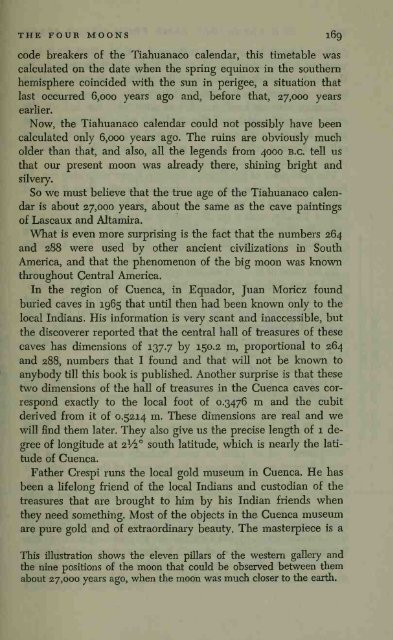Create successful ePaper yourself
Turn your PDF publications into a flip-book with our unique Google optimized e-Paper software.
THE FOUR MOONS 169<br />
code breakers of the Tiahuanaco calendar, this timetable was<br />
calculated on the date when the spring equinox in the southern<br />
hemisphere coincided with the sun in perigee, a situation that<br />
last occurred 6,000 years ago and, before that, 27,000 years<br />
earher.<br />
Now, the Tiahuanaco calendar could not possibly have been<br />
calculated only 6,000 years ago. The ruins are obviously much<br />
older than that, and also, all the legends from 4000 B.C. tell us<br />
that our present moon was already there, shining bright and<br />
silvery.<br />
So we must believe that the true age of the Tiahuanaco calendar<br />
is<br />
about 27,000 years, about the same as the cave paintings<br />
of Lascaux and Altamira.<br />
What is even more surprising is the fact that the numbers 264<br />
and 288 were used by other ancient civilizations in South<br />
America, and that the phenomenon of the big moon was known<br />
throughout Central America.<br />
In the region of Cuenca, in Equador, Juan Moricz found<br />
buried caves in 1965 that until then had been known only to the<br />
local Indians. His information is very scant and inaccessible, but<br />
the discoverer reported that the central haU of treasures of these<br />
caves has dimensions of 137.7 by 150.2 m, proportional to 264<br />
and 288, numbers that I found and that will not be known to<br />
anybody till this book is pubHshed. Another surprise is that these<br />
two dimensions of the hall of treasures in the Cuenca caves correspond<br />
exactly to the local foot of 0,3476 m and the cubit<br />
derived from it of 0.5214 m. These dimensions are real and we<br />
will find them later. They also give us the precise length of 1 degree<br />
of longitude at 2}/!° south latitude, which is nearly the latitude<br />
of Cuenca.<br />
Father Crespi runs the local gold museum in Cuenca. He has<br />
been a lifelong friend of the local Indians and custodian of the<br />
treasures that are brought to him by his Indian friends when<br />
they need something. Most of the objects in the Cuenca museum<br />
are pure gold and of extraordinary beauty. The masterpiece is<br />
a<br />
This illustration shows the eleven pillars of the western gallery and<br />
the nine positions of the moon that could be observed between them<br />
about 27,000 years ago, when the moon was much closer to the earth.

















